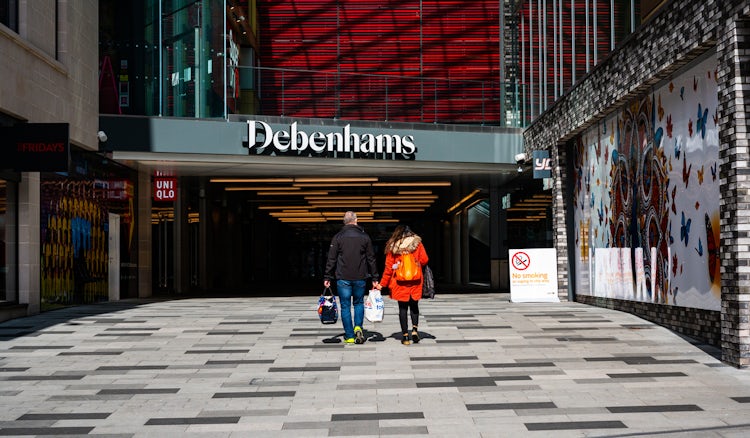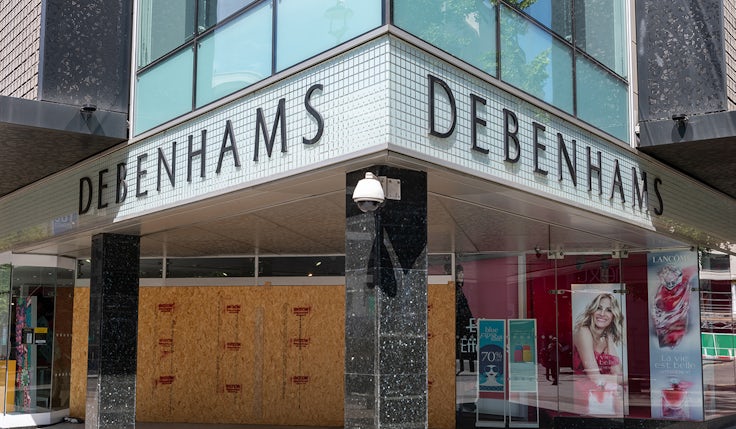There’s no downside for Boohoo in buying Debenhams’ brand
Critics might scorn the fit but consumers care little about corporate ownership, and acquiring the Debenhams brand at a knockdown price helps Boohoo target more profitable customers.
 There was plenty of head-scratching at Monday’s announcement that fashion newcomer Boohoo had bought the Debenhams brand. The price is clear – Boohoo will fork out £55m for the failed, ancient department store. But what exactly is it buying and why is it buying it?
There was plenty of head-scratching at Monday’s announcement that fashion newcomer Boohoo had bought the Debenhams brand. The price is clear – Boohoo will fork out £55m for the failed, ancient department store. But what exactly is it buying and why is it buying it?
In marketing circles, it is quite common to hear someone announce that “brand is one of the company’s biggest assets”. It’s usually a bit of esoteric bullshit. Something to say when a marketer makes the case for marketing investment or against discounting. But it is a statement that is literally correct for a lot of large organisations. Total up all the assets that a company owns and, in many cases, the brand equity of that company – or brand equities if it owns multiple brands – will often exceed a lot of the other company possessions and garner a multibillion-dollar valuation.
Boohoo eyes new customer base with Debenhams deal
“If you gave me a choice,” the famed Coca-Cola CEO Roberto Goizueta once said, “between owning the name Coke and all our factories and trucks… I would choose the name Coke.” It’s a lovely, inspiring thing to say. But it was also a savvy bit of valuation. At the time Coke’s financial brand equity – the value of its name – was almost certainly more than most of the company’s tangible assets.
In the latest Brand Finance league tables, published this week, the Coke brand is now estimated to be worth around $33bn. That sounds like a ton of money but, given Coca-Cola’s overall market capitalisation is just over $200bn, it means that Big Red accounts for just 15% of the company’s total value these days. That’s still sizeable when you consider that the parent company owns and operates hundreds of other brands, and not just Coke. But it’s a significant drop from the powerhouse days when Coke’s brand value represented 30% or 40% of the total value of its parent company.
A brand valuation is useful when a company wants to either fend off an unwelcome takeover or increase the price of any favoured potential acquisition. It’s quite common to see brand equity as part of the overall purchase price when one company acquires another. Back in 2008, for example, when Lloyds bought HBOS for the equivalent of £12bn, the value of the Halifax and Bank of Scotland brands made up around 5% of the total purchase price.
Multigenerational appeal
Many people have lumped the Boohoo acquisition of Debenhams with the similar attempt by Asos to buy Topshop. But the Asos deal is far more typical. Asos will buy the whole company if the deal goes through and then winnow it down to what they want to keep. What makes the Boohoo/Debenhams deal unusual is that the acquirer is just buying the brand name and its website.
Boohoo has no interest in the 124 Debenhams stores, or its infrastructure or stock or employees. It just wants the brand. And given the administrators of the failed retailer gave up on selling the whole business long ago, they were more than happy to accept any offers for any part of the company.
The purchase price of £55m represents about half of Boohoo’s profits from last year. That’s a big investment. But the deal makes a ton of sense and really puts Boohoo on the map as a major retail player in the UK. Just look what it enables Boohoo to do in the coming years.
Cynics might argue that Boohoo’s ownership of Debenhams will taint and destroy the brand’s appeal. But they would be wrong.
Debenhams has a multigenerational appeal. Until recently it was still one of the 10 most visited fashion retailers on the high street. And this broad appeal will open up many new target segments that Boohoo simply could not have reached.
There is also now the tantalising possibility of product diversification thanks to the Debenhams name. If you can remember your last visit to a Debenhams you will probably recall not only the many floors of fashion but also the shoes, sporting products and homeware. The idea of a Boohoo table cloth or pair of tennis shorts probably does not appeal to many people. But with the Debenhams brand on it, the whole offer suddenly makes sense.
And then there is the price insensitivity that the Debenhams brand confers. It might have been a basket case of a company at the end, but it is a brand that still carries enormous amounts of awareness among consumers and not insignificant levels of brand image. That combination means that consumers will expect to pay more for Debenhams gear once Boohoo reopens it for business online.
That’s a critical attraction for Boohoo, which is cursed with a fashion brand that is popular but only profitable through squeezing costs and maximising scale. Selling skinny jeans for eight quid, with a further £1.60 knocked off in the January sale, might make teenagers happy. But it’s a crappy way to make serious profits. Debenhams does not just bring older and richer consumers into view, it also presents a significant opportunity to charge them more too.
And remember that the Debenhams website was also part of the acquisition. That means Boohoo will enjoy the best of both worlds. Front of house it has bought a great old name and a very popular website. But, back of house, it is business as usual. Boohoo can operate and supply this new Debenhams business with its existing infrastructure and core competence. Synergy is what the consultants call it. And for once that word can be legitimately applied. The combination of old-world brand equity and new world logistics and merchandising is a potent one. Especially at this knock down price.
A different kind of brand
And, of course, that is the real story at the heart of this deal. The tale of old bricks-and-mortar stores that were caught out by Covid-19 and the sudden drop in traffic to their stores. And the story of nimbler ‘etailers’ that not only dodged the bullet of an empty, expensive retail infrastructure during lockdown, but benefited from all the home shopping that subsequently ensued. This is their moment not to triumph over the traditional brands but to buy these brands and add them to their stable.
The big question for Mahmud Kamani and his team of retail all-stars at Boohoo is whether they will now be able to manage such a different brand, product mix and target market. It might sound simple but too often companies get good at a certain kind of business and find it all but impossible to accommodate the changing requirements that new brands bring. Kamani’s sons made a big success of Pretty Little Thing. But it’s a brand very much in the image of its big sister Boohoo. Running Debenhams will prove a much bigger challenge.
Cynics might also argue that Boohoo’s ownership of Debenhams will taint and probably destroy the brand’s appeal in the eyes of consumers. But they would be wrong. Most consumers have no clue which companies own which brands.
Debenhams, for example, has had a myriad of sister brands and owning companies during its two centuries of existence. At various stages of operation it was connected to Harvey Nichols and then to Burtons, for example, and yet most of its loyal shoppers would have been none the wiser. No-one links VW to Bentley or Reebok to Adidas (although that relationship might be about to be broken). The sinewy threads of corporate ownership remain invisible to the myopic eye of the shopper.
Every which way you look at the Debenhams acquisition, it looks good. A great price. A great opportunity to diversify. And a perfect synergy between the old and new world of retailing. The ascent of Boohoo continues.







Comments